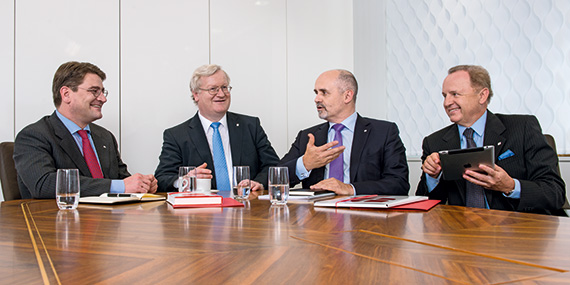
From left to right: Peter Höfinger, Martin Simhandl, Peter Hagen, Franz Fuchs
An interview with the Vienna Insurance Group Managing Board on developments during financial year 2013, strategic plans and the special nature of one of the leading insurance groups in Austria and Central and Eastern Europe.
The interviewers: The questions for the Managing Board were asked by customers, economic experts and VIG employees, and provide answers to some of the key questions for the future in this report.
From a macroeconomic point of view, 2013 was a mixed year for Europe. How was it for VIG?

Question by
Friedrich Mostböck
Head of Group Research, Erste Group, Austria
Hagen: In overall terms, I think we can be quite satisfied with developments in 2013. There were some challenges, of course, but VIG’s broad base, which now extends to 24 countries, is an especially beneficial asset in a volatile environment. We increased our earnings, significantly increased premiums and expanded our market position in many of these markets also in 2013. However, achieving healthy sustainable growth also means foregoing premium growth in the short term when necessary. Take Romania, for example, where we are intentionally refusing to participate in the price war for motor vehicle insurance, even if it means lower premiums in 2013. Or Italy, where we had to focus on a sustainable reorganisation of our product portfolio in the motor vehicle insurance business. And in Poland, we have exercised restraint with respect to single-premium life insurance. In view of these developments, our 4.4% decline in premiums to EUR 9.2 billion is consistent with our top priority: profitable growth rather than growth at any price.
Which markets performed particularly well in 2013?

Question by
Ivan Sabo
Customer of Kooperativa, Slovakia
Höfinger: I can give you a number of examples. With respect to premium growth, our Group companies in the Baltic States, Hungary, Serbia, Slovakia, Turkey and the Ukraine achieved particularly sizeable growth rates. The “Remaining Markets” segment broke through the EUR 1 billion mark for the first time, and we are especially proud of this achievement. However, I think it is also important that we significantly increased our profit before taxes in many of our CEE markets – the Baltics, Bulgaria, Croatia, Poland and Turkey, for example.
Hagen: I would like to add that we can be quite satisfied with premium growth in 2013 in Austria, which continues to be our most important single market, as Wiener Städtische and s Versicherung achieved solid performances.
To what extent did the decrease in premiums nevertheless have an effect on earnings growth?

Question by
Friedrich Mostböck
Head of Group Research, Erste Group, Austria
Simhandl: If you analyse earning growth in 2013, the premium losses suffered in some markets actually turned out to be less important, while the negative developments mentioned in Italy and Romania had an extremely dramatic effect. This is why it was especially important that we introduced and implemented numerous measures to increase profitability in these countries. If you look at the CEE countries without Romania, our earnings increased by around 2%. The bottom line, however, is that after achieving a record value in the previous year, Group profit declined by 37.0% to EUR 355.1 million. This includes goodwill impairment losses in Romania and provisions in Italy.
What effect did this have on the combined ratio?

Question by
Friedrich Mostböck
Head of Group Research, Erste Group, Austria
Simhandl: The factors mentioned caused the combined ratio to rise from 96.7% in the previous year to slightly more than 100%, although natural disasters like the flood at the beginning of the summer also played a certain role. Even though we view this as a temporary increase due to the special effects, we are making every effort to further improve efficiency and profitability throughout the Company.
What measures have you taken as a result of the current developments in Romania and Italy?

Question by
Gerald Klemensich
Head of Reinsurance Vienna Insurance Group, Austria
Fuchs: Our strategy in Romania is quite clear: we remain committed to not participating in the irrational behaviour of several competitors. The current dumping prices in the motor vehicle insurance business have absolutely no relationship to cost pricing and are ruinous for the entire line of business. We will therefore continue to reduce our motor liability portfolio and focus on other lines of business. This strategy is accompanied by strict cost management and effective measures for improving claims management.
Hagen: I am confident that the accounting and personnel measures implemented in Romania have created a healthy starting point for 2014 and beyond. The measures implemented in 2013 in Italy also went beyond personnel changes and included extensive measures to reorganise our portfolio.
VIG is proud of the wide diversity of its brands. To what extent does this local orientation prevent Group-wide synergies?

Question by
Olga Reznik
CEO Compensa Life Baltic States, Estonia
Höfinger: We do not see our brands simply as logos for our Group companies. They are an expression of our regional ties and proximity to our customers. Many of these brands were established years ago and in some cases decades ago. They symbolise the independence that our local Group companies can experience under the VIG umbrella while complying with Group guidelines. These are very important benefits that represent the very core of VIG. But at the same time, our multi-brand strategy does not prevent us from exploiting synergy effects at the Group or country level. Departments without direct customer contact, such as accounting or investments, are regularly being bundled together in countries with more than one Group company in order to benefit from the cost advantages. However, Group-wide initiatives that form part of our business strategy are also important. An example is our SME initiative, which we used to carefully target small and medium-sized enterprises in our markets in 2013. This allowed us to achieve a significant increase in premiums in this important customer segment.
In your opinion, what sets VIG apart from its competition? Isn’t all insurance the same?

Question by
Ivan Sabo
Customer of Kooperativa, Slovakia
Fuchs: In my view these are a number of different aspects. As previously mentioned, we consider our multi-brand strategy to be a definite advantage because it ensures a differentiated approach when developing different markets. This is because the insurance business is essentially a local business, even though it is exposed to global developments. There are fundamental differences between the current needs of our customers in the Ukraine or Bulgaria and those of our customers in Austria. It would therefore be completely counter-productive and arrogant to try and sell a standard range of products to all of our markets from the Ringturm building in Vienna. VIG stands out instead for its ability to handle the special characteristics of different regions. To do so, we rely on the market knowledge of our local employees and managers; they know best which insurance products are needed by the people in their area, and they can react quickly and skilfully to changes.
Hagen: The rapid rate of change in our markets requires quick decision-making, and our decentralised organisational structure makes this possible. This means, for one thing, that approval powers and decision-making authority remain with the local management team, along with all the consequences that this implies, including the personal responsibility borne by management. I have to admit that it is not always easy to do this. However, last but not least it is the dedication and the skills of our around 23,000 employees that are responsible for VIG’s success.
What are your most important strategic plans for coming years?

Question by
Maria Culescu
Founder and President of the aid organisation M.A.M.E., Romania
Hagen: We are following a sustainable growth strategy with two primary objectives. We want to further consolidate our leading market position in Austria while fully exploiting the growth potential in the CEE region over the long term. At the same time, we are focusing on what we do best: insurance – our core business. We are also relying on the multi-brand strategy previously mentioned, which allows us to broadly diversify our distribution channels. As always, our highly successful cooperation with Erste Group plays a very special role in this regard.
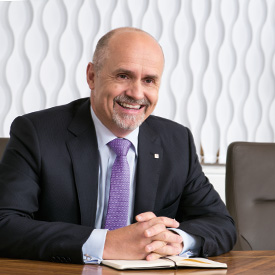
“We want to consolidate our leading market position in Austria and fully exploit the growth potential in the CEE region.”
Peter Hagen
What role will the Central and Eastern European countries play in our Group strategy?

Question by
Dorota Czerwinska-Rybska
Managing Board member Polisa, Head of HR Compensa, Poland
Fuchs: It is clear to me that they will play a key role. Our CEE markets already generate more than 50% of Group premiums, and a closer look at insurance density shows that they are set to become even more important. While annual per capita insurance expenditures are close to EUR 2,000 in Austria, the comparable figure for the CEE region is around EUR 200. In addition, around 170 million people live in our CEE markets. People who, in spite of setbacks due to the crisis, are working their hardest to push forward the process of economic convergence in their countries. From a strategic point of view, however, we do not think of the CEE as a homogeneous region. Economic momentum varies greatly between these countries, as do political and social factors. These are important differences that we also have to take into account when defining our strategy.
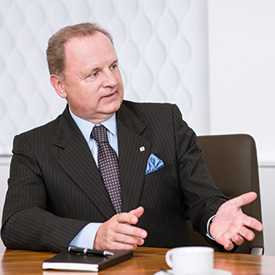
“Our CEE markets already generate more than 50% of Group premiums and the great potential of these markets means they will become even more important in the future.”
Franz Fuchs
Höfinger: Our clear commitment to the CEE region is also shown by our latest expansion measures: the acquisition of AXA Biztosító in Hungary and Skandia Poland, the conclusion of the acquisition of Makedonija Osiguruvanje and the announcement of the acquisition of Donaris in Moldova at the beginning of 2014. The next steps are to secure the long-term stream of income generated by these investments and continuously increase the earnings contributed by the CEE markets.
To what extent will Solvency II affect VIG’s strategy and day-to-day work within the Company?

Question by
Gerald Klemensich
Head of Reinsurance Vienna Insurance Group, Austria
Hagen: Solvency II does not require a major change in our strategy. On the contrary, it confirms our risk-conscious business policy and will lead to a more in-depth focus on these processes. After all, the European Commission is using the Solvency II regulations to pursue two major objectives: first, to provide insurance customers with better protection against the insolvency of individual insurance companies and secondly, to ensure proper operation of the European insurance market. As a responsible insurance group, we can only welcome these two objectives. The models and approaches currently being discussed, however, will involve enormous bureaucratic effort and expense.
Simhandl: The Solvency II capital requirements for covering the risks assumed by insurance companies is not a problem. Our solvency ratio according to Solvency I was higher than 200% at the end of 2013. This surplus cover is a clear indicator of VIG’s financial stability, which we will ensure to maintain in the future. In addition, the successful issue of our subordinated bond in October 2013, whose volume of EUR 500 million was oversubscribed several times, shows how attractive VIG is for the bond market.
What dividend can our shareholders expect for 2013?

Question by
Roman Brablec
Head of Reinsurance Kooperativa and CPP, Czech Republic
Simhandl: For years we have followed a dividend policy that distributes a minimum 30% of our Group profits after taxes and non-controlling interests to our shareholders. As previously mentioned, the decrease in Group profit in 2013 is the result of special issues, not the development of the Group in general. Based on good operating performance and our strong capital base, we will be proposing a dividend of EUR 1.30 per share at the Annual General Meeting in June 2014. This proposal should also be seen as an expression of our conviction regarding VIG’s future positive development.
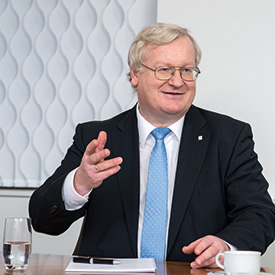
“We are following a sustainable dividend policy and will propose a dividend of EUR 1.30 per share at the Annual General Meeting for financial year 2013.”
Martin Simhandl
The VIG Annual Report for 2013 is based on the motto “Our confidence in the future unites us”. What is your confidence in the future business development of VIG based on?

Question by
Nikolina Dražeta
Key Account Manager Wiener Osiguranje, Croatia
Hagen: In addition to VIG’s excellent strategic position, I am firmly convinced that the economic convergence process will continue in our Central and Eastern European markets, in spite of the current challenges. We are living in an exciting time that is full of opportunities. With great courage and pioneering spirit, Vienna Insurance Group has laid a solid foundation in the past for our future growth and success – today we are number one in our core markets. We now have to build upon this foundation, and not only recognise opportunities, but also make use of them. And I am confident that working together with our employees we can achieve this.
The financial and economic crisis has also led to a more difficult social climate. How is VIG dealing with this?

Question by
Maria Culescu
Founder and President of the aid organisation M.A.M.E., Romania
Höfinger: We feel a special connection to the people in our markets, and VIG and its Group companies consequently feel a great deal of social responsibility. Our principal shareholder, Wiener Städtische Versicherungsverein, regularly supports our activities in this regard and also implements many initiatives itself. The focus is on assisting regional social organisations and projects that are chosen locally by our Group companies and contribute to the long-term improvement of living conditions.
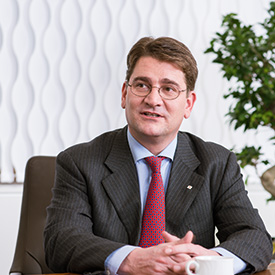
“We feel a special connection to the people in our markets, and VIG and its Group companies consequently feel a great deal of social responsibility.”
Peter Höfinger
Fuchs: The “Social Active Day” is certainly one of our most important social initiatives. Our employees are allowed to take one day off during the year to perform social activities in a wide variety of institutions. These activities range from renovation work in social aid organisations and nursing care facilities to food collection and providing care to the elderly. The number of Group employees participating in this project has grown continuously since it was first launched in 2011. In 2013, 19 countries took part. More than 4,500 working days were provided for volunteer work, corresponding to around 36,000 working hours that we provided free of charge for the collective good. I think we can be very proud of this.
Let us close by looking into the near future. What is the outlook for 2014?

Question by
Birgit Moosmann
Head of People Management Vienna Insurance Group, Austria
Hagen: The positive development and success we achieved in many of our markets in 2013 make me quite optimistic. Even though 2014 is not going to be an easy year in macroeconomic terms, I am convinced that we will be able to continue the successful course of VIG. The optimisation measures we implemented in Romania and Italy in 2013 will further improve efficiency in 2014. And our goal of growing faster than the overall market remains unchanged in 2014.

